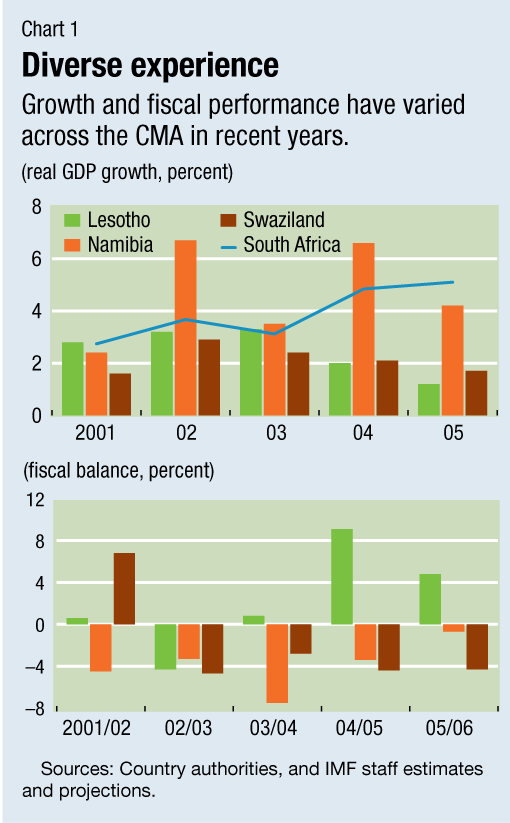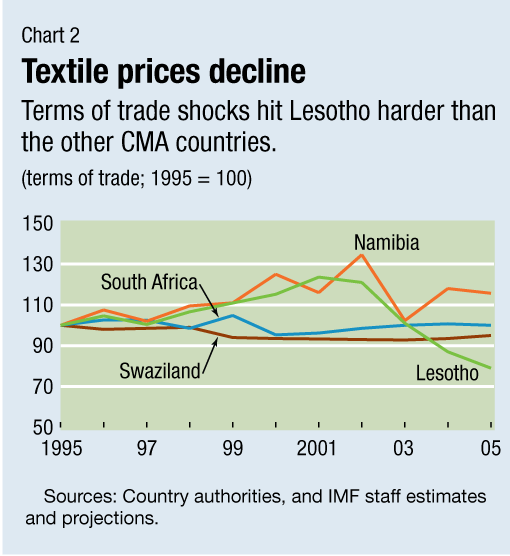
Typical street scene in Santa Ana, El Salvador. (Photo: iStock)
IMF Survey: Southern Africa: Adapting to Shocks
February 21, 2008
- Southern African monetary union has benefited members, but now faces challenges
- The better countries respond to shocks, the more they stand to benefit
- Additional reforms could facilitate adjustment and improve prospects
Although Southern Africa's Common Monetary Area (CMA) has facilitated cross-border trade and capital flows and helped maintain price stability, growth would be more broadly shared if member countries adopted additional reforms to help particularly the small ones adjust better to external shocks, according to an IMF study.

A diamond-cutter in Namibia, one of four countries that make up the Southern African Common Monetary Area (photo: Brigitte Weidlich/AFP).
COMMON MONETARY AREA
The CMA, launched in 1986 and comprising Lesotho, Namibia, South Africa, and Swaziland, has benefited its members. There is strong evidence that it has facilitated the development of a regional market for goods and services. Available data also confirm that the CMA countries, anchored by price developments in South Africa, have had lower inflation than their neighbors in the region.
Still, growth and fiscal performance in the four countries varies widely (see Chart 1).
Recent changes in the global environment have posed new challenges to the members as they strive to achieve greater common prosperity—a goal of the CMA. Adopting reforms to increase macroeconomic policy coordination and market flexibility would help member countries, especially the smaller ones, adjust better to external shocks, the IMF study finds.

Withstanding shocks
The net gains of a monetary union to its members hinge on how well the members adjust to external shocks, such as changes in the value of export commodities. Two variables that affect the adjustment process are whether the shocks affect the member countries equally or differently and whether the policy and institutional framework of the union facilitates adjustment.
The available data show that shocks to the terms of trade in the CMA countries are asymmetric (see Chart 2), largely because the countries have different exports whose world prices do not move together. For example, the world market prices of gold, platinum, and iron ore—which accounted for over half of South Africa's exports in 2005-06—have surged since the late 1990s.

During the same period, declining prices of textile products—which accounted for over 75 percent of Lesotho's exports in 2005-06—have weakened its terms of trade. Namibia's terms of trade are heavily influenced by changes in the prices of diamonds and other minerals, and sugar prices are important for Swaziland.
Recent adjustment experiences
South Africa's economy was profoundly affected by the removal of economic sanctions in the early 1990s and a sharp rise in gross capital inflows and outflows. A key element of South Africa's stabilization strategy was to strengthen public finances. This effort lowered the public sector borrowing requirement, which supported measures to reduce inflation and stimulate growth. In addition, over the past decade, the South African Reserve Bank has moved from a pegged exchange rate to a monetary policy based on inflation targeting and a free float of the rand. This move helped South Africa cope with changes in its terms of trade and capital flows, reducing its vulnerability to shocks.
Although a more flexible exchange rate helped South Africa respond to shocks, the impact on other CMA countries varied. Because they peg their currencies to the rand, movements of the rand exchange rate affect their external competitiveness. These countries have also had to cope with other events, such as the persistent drought that has hurt Lesotho and Swaziland.
Economic growth in Lesotho was also weakened by a sharp drop in workers' remittances relative to GDP in 1996-2000 and the elimination of textile quotas by industrial countries in January 2005. Lesotho implemented a prudent fiscal policy, but nonetheless ran a fiscal deficit, financed largely through domestic borrowing.
Although the shocks Swaziland experienced were similar to, or less severe than, those that hit the other CMA countries, it lagged behind in adjustment and output recovery. When investors returned to South Africa after its democratization in 1994, Swaziland saw a decline in foreign direct investment. Sharp increases in the wage bill and other spending caused the overall fiscal deficit to widen in 2004/05-2005/06, and real GDP growth continued to weaken. Like Lesotho, Swaziland, ran a fiscal deficit financed through domestic borrowing.
Namibia was affected by an exchange rate appreciation in 2002, a deterioration of its terms of trade in 2003, and a consequent widening of its fiscal deficit. Although strong growth in the production and exports of diamonds and other minerals helped offset the negative effect of the exchange rate appreciation, the Namibian government has sharply reduced its fiscal deficit since 2004. The country has enjoyed record exports, strong external current account surpluses, and moderate inflation.
Policy issues
Shocks to CMA countries are likely to remain asymmetric in the period ahead. CMA policymakers will thus need to focus on ensuring timely and effective adjustment if their economies are to achieve sustained economic growth. They will need to focus, in particular, on efforts in several areas:
• Macroeconomic coordination. Close macroeconomic policy coordination is at the core of most existing monetary unions. Indeed, because maintaining a sustainable fiscal position is so crucial for the success of a monetary union, explicit ceilings on fiscal deficits and total government debt are often set as convergence criteria for new entrants or as part of a fiscal code of conduct for the membership. In the CMA, explicit limits on fiscal deficit and public debt have not been used so far. However, as asymmetric shocks become more severe, the disadvantages of the lack of regional surveillance on fiscal and structural policies become more apparent. A rule-based fiscal framework could be an effective discipline device.
• Market flexibility. A flexible labor market will facilitate regional integration and effective adjustment to asymmetric shocks. Despite the region's long history of labor mobility, efforts to liberalize the cross-border movement of labor may have to face the reality of high unemployment. But some steps could be taken to improve the situation and reduce wage rigidity. Measures to harmonize immigration practices—such as standardizing immigration forms, streamlining visa requirements, and improving immigration facilities both where travel documents are issued and at border crossings—have already been discussed and could be implemented relatively quickly once the countries reach a consensus. Streamlining and simplifying the regulations on labor entry and work permit and other requirements would facilitate the movement of labor, including skilled labor, and lower the costs for private sector-led growth in the region.
• Full monetary union. Moving to a full monetary union with a single currency, pooling of foreign reserves, and a common monetary authority would increase the credibility of monetary policy in the small countries. A single currency by itself will not, however, significantly increase the effectiveness of the CMA in response to asymmetric shocks unless it is accompanied by efforts to increase market flexibility and macroeconomic coordination and cooperation.
Comments on this article should be sent to imfsurvey@imf.org.


